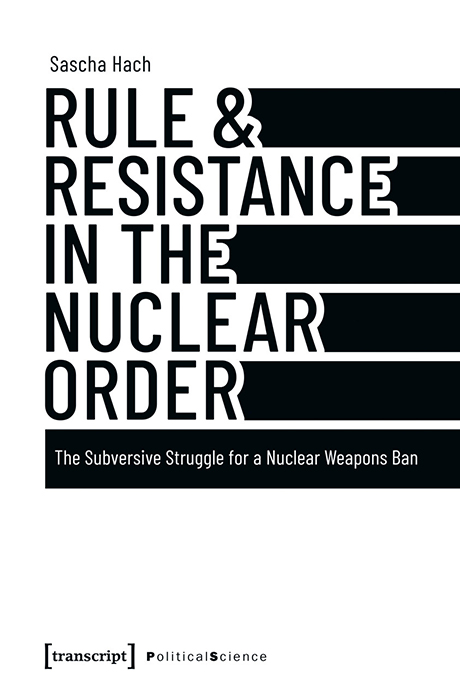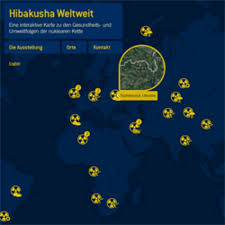Willkommen auf der Seite der "Textinitiative Fukushima"
Die Seiten der Textinitiative Fukushima werden derzeit von der Japanologie der Goethe-Universität betrieben. Gegenwärtiges Anliegen von TIF ist die zeitgeschichtliche Dokumentation. Das Forum dient nun in erster Linie als Archiv für Informationen zu 3/11 sowie allgemein zur Geschichte des Atomaren. Die Suchfunktion ermöglicht Recherchen zu Stichworten, Inhalten und Akteuren.
| Publikation "Rule & Resistance in the Nuclear Order“ von Sascha Hach (2025) | 15.04.2025 |
Link: https://www.prif.org/en/press/details/ohne-macht-wie (PRIF) ----------------------------- |
|
| WELTKARTE der "hibakusha" | 14.04.2025 |
Zitate: "Im Japanischen werden die Überlebenden von Hiroshima und Nagasaki „Hibakusha“ genannt. Viele von ihnen setzen sich für eine Welt frei von atomarer Bedrohung ein – meist, indem sie den jüngeren Generationen ihre Geschichte erzählen. Überall auf der Welt folgen andere mutige Menschen ihrem Beispiel. Als Ärztinnen und Ärzte sehen wir uns in der Pflicht, über die Zusammenhänge der zivilen und militärischen Atomindustrie und über die gesundheitlichen Gefahren von Radioaktivität aufzuklären. Daher diese Ausstellung mit Orten, an denen sich ihre katastrophalen Folgen für Umwelt und Gesundheit zeigen. Präsentiert wird dabei nur eine kleine Auswahl an exemplarischen Orten. " "Nach Beginn der Atomkatastrophe in Fukushima im März 2011 bekam der Begriff in Japan eine neue Bedeutung: Nun nannten sich auch die Betroffenen der Atomkatastrophe von Fukushima so. Vielen Menschen wurde erstmals bewusst, dass Atomenergie und Atomwaffen zwei Seiten der selben Medaille sind (...)" ------------------------------ "Tokai-mura, eine kleine Stadt 120 km nordöstlich von Tokio, wird oft als das Herz von Japans Atomindustrie bezeichnet. 1956 entstand hier das japanische Atomenergie-Forschungsinstitut, gefolgt von Fabriken zur Herstellung von atomarem Brennstoff, Anlagen zur Wiederaufbereitung von Brennelementen und Japans erstem Atomkraftwerk. Heute stehen in Tokai-mura insgesamt 15 Atomanlagen einschließlich einer Brennstoffkonversionsfabrik. Hier wurde am 30. September 1999 Mischoxid-Brennstoff für den experimentellen Schnellen Brüter in Joyo hergestellt. Normalerweise wird dabei zunächst Uran in Form von „Yellowcake“ in Salpetersäure gelöst. Um den Prozess zu beschleunigen und so Geld zu sparen, füllten an diesem Tag Arbeiter der Anlage den Präzipitationsbehälter mit 16,6 kg Uran statt der erlaubten 2,4 kg. Die so entstandene kritische Masse löste eine atomare Kettenreaktion aus, die über einen Zeitraum von 20 Stunden große Mengen an Neutronen- und Gamma-Strahlung freisetzte. 161 Menschen mussten evakuiert werden; etwa 310.000 Einwohner im Umkreis von zehn Kilometern um die Anlage wurden aufgefordert, in ihren Häusern zu bleiben, da eine radioaktive Wolke mit strahlenden Partikeln wie Jod-131 durch das Belüftungssystem in die Atmosphäre geblasen worden war." Links: https://hibakusha-worldwide.org/de (IPPNW) |
|
| Das Archiv für alternatives Schrifttum (afas) in Duisburg | 10.04.2025 |
Um eine Zeitgeschichte des Atomaren zu verfassen, ist der Blick ins Duisburger Archiv von Nutzen. Hier finden sich eine Reihe von Dokumenten und selteneren Ephemera der Anti-Atomkraftbewegung / der Ökologie und Friedensbewegung (seit den 1980er Jahren). "Ein Teil der Materialien ist bereits katalogisiert und die dazugehörigen Findbucheinträge sind entweder über die Online-Recherche (siehe Katalog) oder bei uns im Archiv am Rechner einzusehen. Persönliche und interne Materialien wie Handakten, Protokolle, Manuskripte und Korrespondenzen werden nur in Absprache mit den GeberInnen für die Nutzung zur Verfügung gestellt" (afas Homepage) Links: https://afas-archiv.de/Suchergebnisse/?search
|
|
| Post-Fukushima-ANIMISMUS: Kunst, Texte, Analysen - TAKEDA Tetsu | 08.04.2025 |
"A unique graffiti brushstroke manifests great emotion of the artist influenced by New York in the 80s, where Tetsu was profoundly inspired by music (hip hop, rock, punk, jazz, etc.), graffiti, and street art at times. His free-flowing expression results a rather dramatic contrast with the poetic imagery. Nature inspired Tetsu to document life around him, his sculpture works made of collected rubbish from the beach shows a desire of restoring our relationship with nature." (About) Links: https://apjjf.org/2024/11/yang (Sia X.Yang, 23. November, Japan Focus, 2024) ------------------------------------------ |
|
| Kunst und Atomares: Ben Shahns "Lucky Dragon-Serie" (1960) | 04.04.2025 |
"In a sense, this work represents the 3rd nuclear attack on the Japanese. Social commentator and artist Ben Shahn depicts Aikichi Kuboyama in a powerful black and white study. Kuboyama was a crew member on a Japanese fishing vessel who died of radiation poisoning following the 1954 H-Bomb test on Bikini Atoll. Along with his crew of 22, they inadvertently wandered into the above-ground nuclear weapon test zone and got covered in the white dust." Links: https://www.artsy.net/artwork/ben-shahn-kuboyama-saga-of-the-lucky-dragon-he-died-from-h-bomb-testing-at-bikini-island
|
|
|
1-5 von 761
|
 "2021 trat der Atomwaffenverbotsvertrag in Kraft, der auf die Initiative von Nicht-Atomwaffenstaaten und zivilgesellschaftlichen Bündnissen zurückgeht. Sein Ziel ist eine Welt ohne Atomwaffen. Zugleich stellt er die Sonderstellung der Nuklearwaffenstaaten und damit die bisherige nukleare Ordnung grundlegend in Frage. Wie konnte dieses Aufbegehren vergleichsweise kleiner Akteure gegen die militärisch mächtigsten Staaten der Welt erfolgreich bestehen? In seiner neuen Buchveröffentlichung „Rule & Resistance in the Nuclear Order“ legt Sascha Hach die Herrschaftsstrukturen des NVV offen und zeigt, wie es der Humanitären Initiative für Nukleare Abrüstung gelang, diese herauszufordern."
"2021 trat der Atomwaffenverbotsvertrag in Kraft, der auf die Initiative von Nicht-Atomwaffenstaaten und zivilgesellschaftlichen Bündnissen zurückgeht. Sein Ziel ist eine Welt ohne Atomwaffen. Zugleich stellt er die Sonderstellung der Nuklearwaffenstaaten und damit die bisherige nukleare Ordnung grundlegend in Frage. Wie konnte dieses Aufbegehren vergleichsweise kleiner Akteure gegen die militärisch mächtigsten Staaten der Welt erfolgreich bestehen? In seiner neuen Buchveröffentlichung „Rule & Resistance in the Nuclear Order“ legt Sascha Hach die Herrschaftsstrukturen des NVV offen und zeigt, wie es der Humanitären Initiative für Nukleare Abrüstung gelang, diese herauszufordern."


